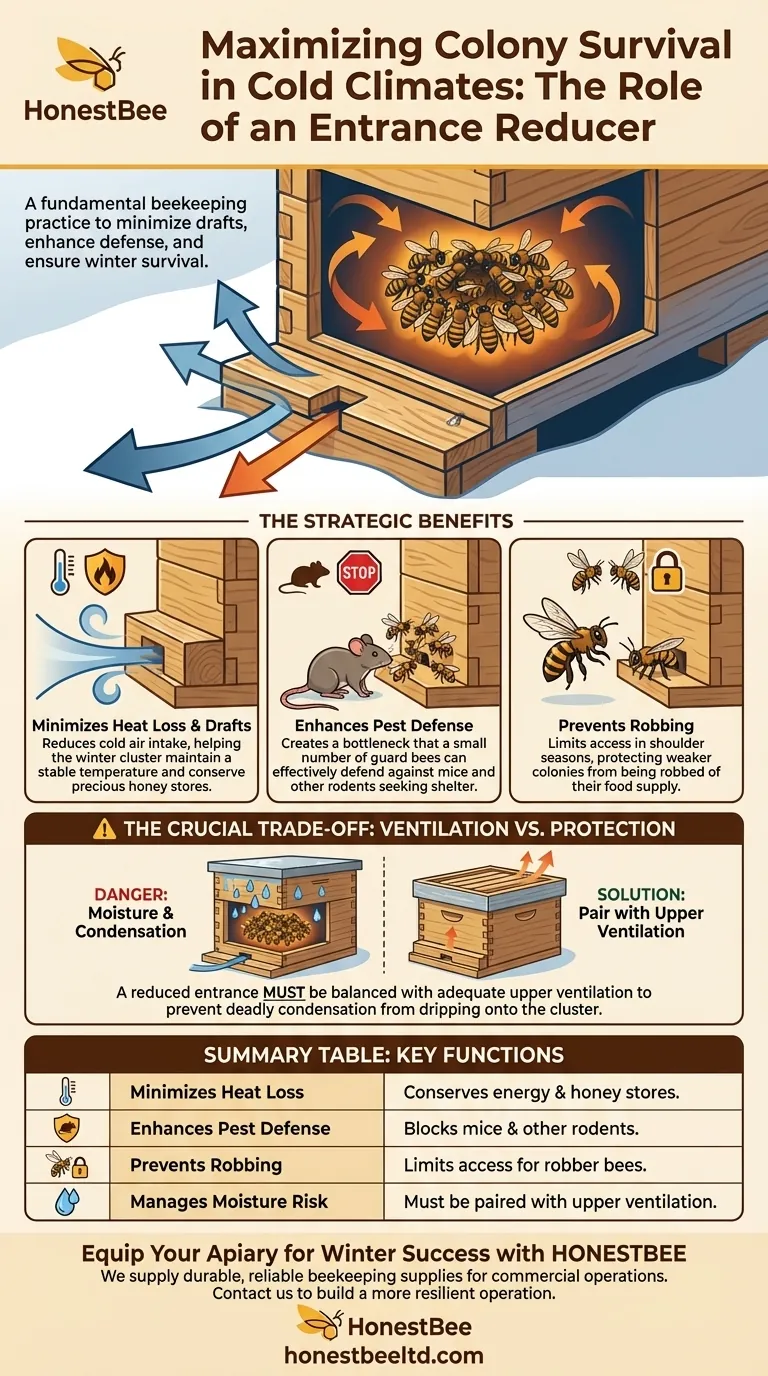In beekeeping, using an entrance reducer in cold climates is a fundamental practice for colony survival. This simple wooden block serves three critical functions: it minimizes cold drafts that stress the hive, helps the colony defend against pests like mice, and prevents snow from completely blocking the entrance. It is a key component of a comprehensive winterization strategy.
The core challenge of overwintering a honeybee colony is not just managing cold, but managing moisture and defense. An entrance reducer is essential for defense and draft reduction, but it must be balanced with proper ventilation to prevent deadly condensation inside the hive.

The Strategic Importance of a Reduced Entrance
A colony's ability to survive winter depends on its efficiency. Bees form a tight cluster and vibrate their wing muscles to generate heat, and any disruption to this process forces them to consume more of their precious honey stores. The entrance reducer is a tool to create a more stable and defensible internal environment.
Minimizing Heat Loss and Cold Drafts
A wide-open entrance in the winter is like leaving a window open in your house. It creates a constant draft that requires more energy to overcome.
By constricting the opening, an entrance reducer significantly cuts down on the cold air flowing directly into the hive. This helps the winter cluster maintain a stable temperature with less effort, conserving honey stores that are critical for survival until spring.
Enhancing Pest Defense
As temperatures drop, mice and other rodents seek warm, sheltered locations with a ready food source. A beehive is a perfect target.
A full-sized entrance is impossible for a small, clustered colony to defend. A mouse can easily enter and destroy comb, consume honey, and foul the hive, often leading to the colony's demise. The small notch of an entrance reducer creates a bottleneck that a handful of guard bees can effectively defend.
Preventing Robbing in Shoulder Seasons
In the late fall or early spring when nectar is scarce, stronger colonies may try to rob weaker ones. A reduced entrance limits access, giving the home colony a fighting chance to repel invaders and protect their food supply.
Understanding the Trade-offs: Ventilation vs. Protection
While an entrance reducer is vital, using it incorrectly can create a more dangerous problem than the one it solves. The biggest killer of honeybee colonies in winter is not cold, but moisture.
The Danger of Condensation
Bees release a significant amount of warm, moist air as they metabolize honey. If this humid air cannot escape, it will rise, hit the cold inner cover, and condense into water droplets.
This cold "rain" dripping down onto the cluster is far more dangerous than low temperatures. Wet bees quickly chill and die. Therefore, a reduced lower entrance must be paired with adequate upper ventilation. This can be an upper entrance hole, a slightly offset inner cover, or a quilt box, all of which allow moist air to escape.
The Risk of a Blocked Entrance
The small opening of a reducer can become blocked by an accumulation of dead bees, which is a natural part of winter die-off.
A blocked entrance prevents the colony from taking crucial "cleansing flights" on warmer winter days to void waste. It's important to periodically check the entrance and clear any deceased bees to ensure it remains open.
Making the Right Choice for Your Goal
The goal is not just to close off the hive, but to create a balanced system that is dry, defensible, and draft-free.
- If your primary focus is pest control: Install the entrance reducer (on a medium or large setting) in early fall as nights get cool, well before mice begin seeking winter shelter.
- If your primary focus is maximum draft protection: Switch to the smallest opening on your reducer after the first hard frost, when the colony has begun to form its winter cluster.
- If your primary focus is hive survivability: Pair your reduced entrance with a dedicated upper vent or entrance to ensure that moisture can escape, keeping the colony dry.
Properly managing the hive entrance is a cornerstone of successful overwintering that empowers your colony to emerge strong in the spring.
Summary Table:
| Benefit | Key Function |
|---|---|
| Minimizes Heat Loss | Reduces cold drafts, helping the winter cluster conserve energy and honey stores. |
| Enhances Pest Defense | Creates a small, defensible entrance to block mice and other rodents. |
| Prevents Robbing | Limits access for robber bees from stronger colonies during scarce seasons. |
| Manages Moisture Risk | Must be paired with upper ventilation to prevent deadly condensation inside the hive. |
Equip Your Apiary for Winter Success with HONESTBEE
Proper winterization is non-negotiable for commercial beekeeping operations. An entrance reducer is a simple yet critical component of a strategy that protects your investment and ensures strong colonies in the spring.
At HONESTBEE, we supply durable, reliable beekeeping supplies and equipment—including entrance reducers—through wholesale-focused operations. We are dedicated to supporting commercial apiaries and beekeeping equipment distributors with the high-quality tools needed for maximum hive survivability.
Let's discuss your winter preparation needs. Contact our team today to learn how our products can help you build a more resilient and profitable operation.
Visual Guide

Related Products
- Beehive Entrance Discs Plastic Bee Entrance Disc for Bee Hives
- Multi-Functional Sliding Hive Entrance for Beekeeping
- Multi-Functional Rotary Hive Entrance Disc for Beekeeping
- Professional Reversible Beehive Hive Entrance
- Wooden Queen Bee Excluder for Beekeeping
People Also Ask
- What does a fully closed setting on a round beehive entrance disc indicate? A Guide to Hive Security
- What should beginners consider when purchasing beekeeping equipment? A Guide to Essential Starter Gear
- What additional components and accessories are available for beehives? Essential Tools for Healthy, Productive Colonies
- How is the circular metal beehive entrance disc mounted? Simple Pivot Installation for Smart Hive Management
- Why is proper beekeeping equipment important? Essential for Safety and Hive Health



















